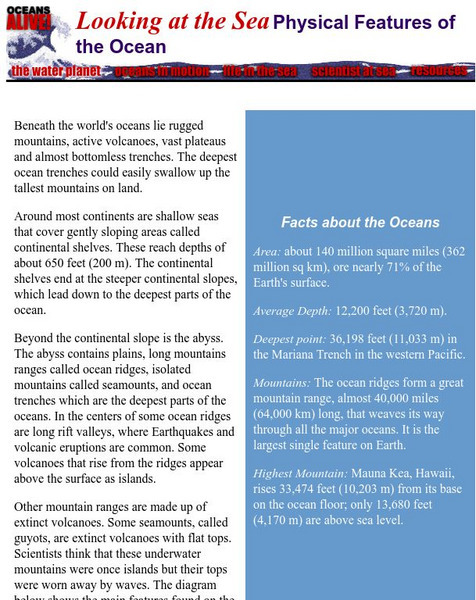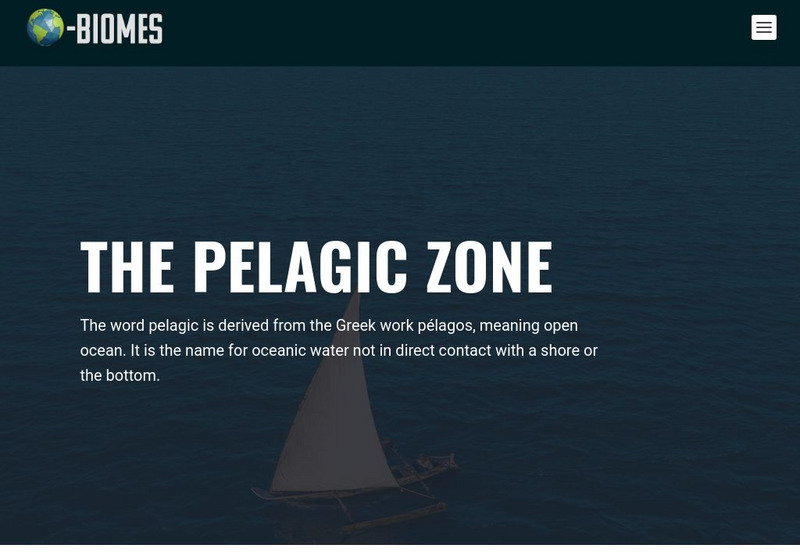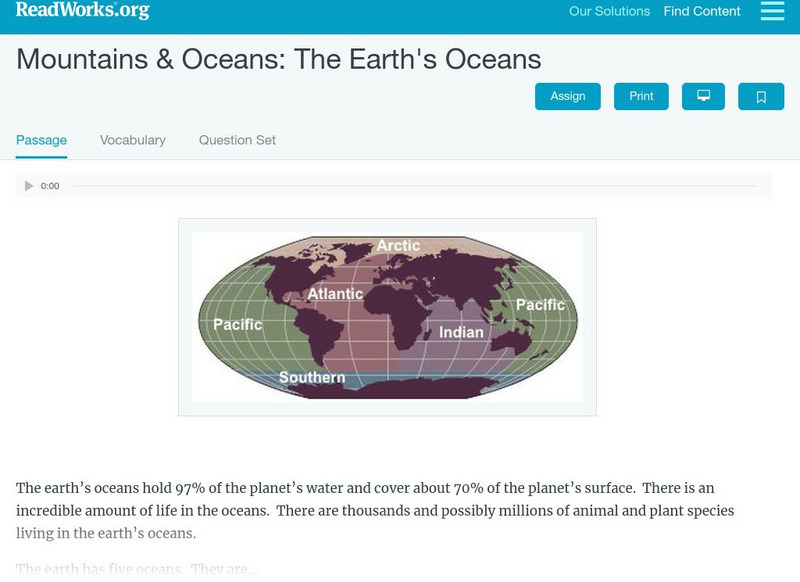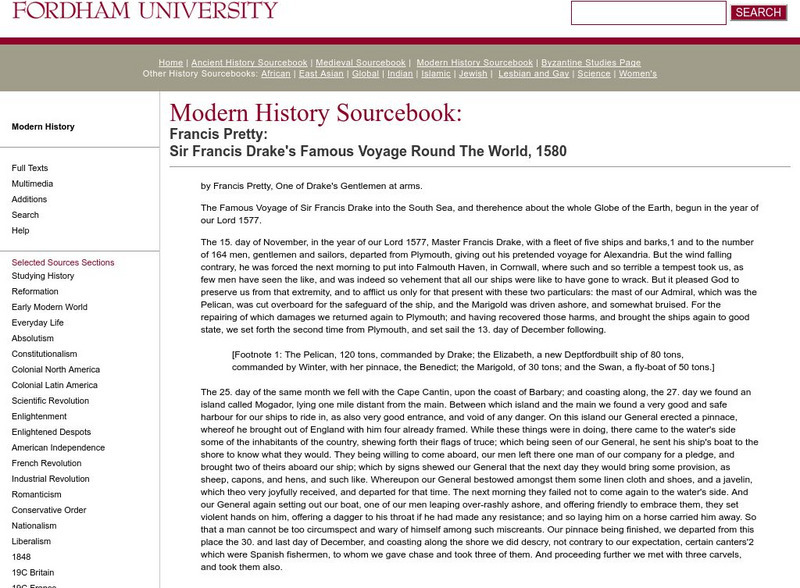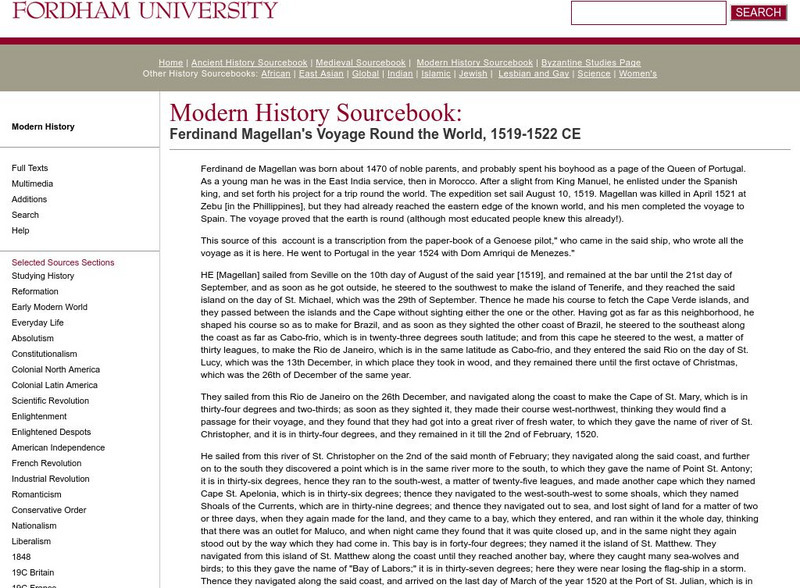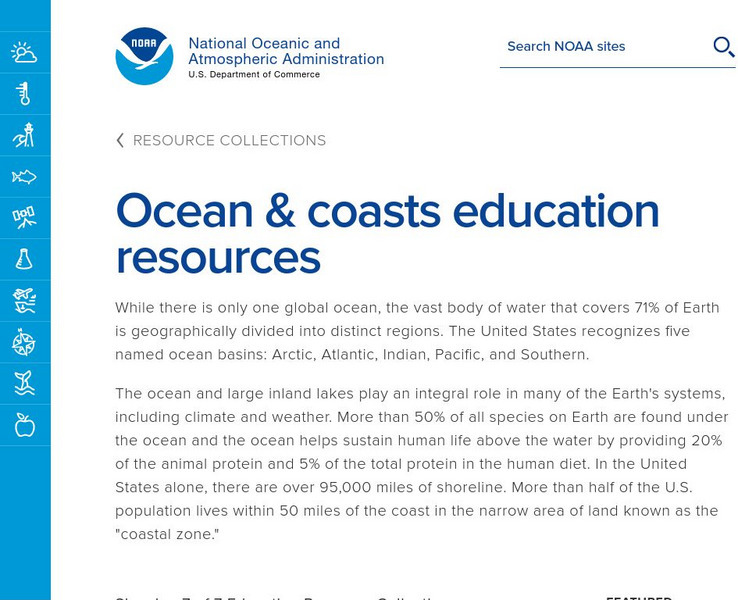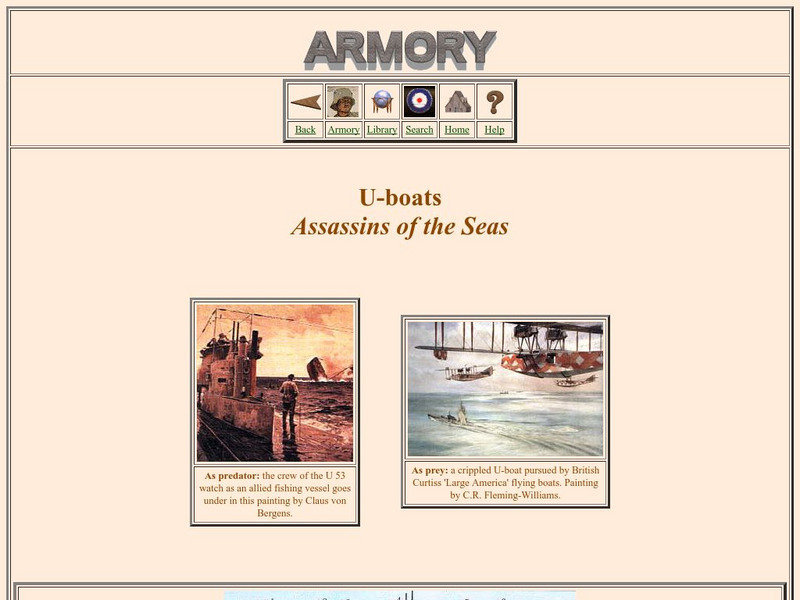PBS
Pbs: Journey to Planet Earth: Seas of Grass
A part of the PBS series "Journey to Planet Earth," this section explores the world's grasslands, some of which are in environmental danger. Includes video and educational resources.
Mariners' Museum and Park
Mariners' Museum: Exploration Through the Ages
A history of the world from the perspective of those who sailed the seas in great waves of exploration, from ancient times through the nineteenth century. Learn about the explorers, their ships, the tools they navigated by, and their...
National Geographic
National Geographic: The World Ocean
A collection of four lessons where students look at the vital role oceans play in our lives, at the hydrosphere and the impact humans have on it, how humans use the oceans and who is responsible for protecting them, and the rationale...
Museum of Science
Oceans Alive! Physical Features of the Ocean
Oceans site explores the physical features that lie deep below the surface of our world's oceans.
Natural History Museum
Natural History Museum: The Oceans
This online exhibit from the Natural History Museum is home to ten units covering various aspects of the world's oceans including frozen oceans, deep oceans, barnacles, coral reef, deep-sea fish, sponges, vents, and more.
Other
Save Our Seas Organization: Home Page
Home page of the Save Our Seas Organization which seeks to protect all the oceans of the world.
A&E Television
History.com: Why the Construction of the Panama Canal Was So Difficult and Deadly
A staggering 25,000 workers lost their lives. And artificial limb makers clamored for contracts with the canal builders. In a quest to fulfill a centuries-old dream to connect the Atlantic and Pacific Oceans, the builders of the Panama...
The Wild Classroom
The Wild Classroom: Biomes of the World: Oceanic Pelagic Biome
Learn about the oceanic pelagic ecosystem. Find out about plants, animals, adaptations, and conservation efforts.
Science Struck
Science Struck: Understanding the Ocean Ecosystem
Describes the two organisms capable of photosynthesis in an ocean ecosystem, the different ocean zones and the plants and animals that live in them, some facts about the ocean, and the five oceans of the world.
The Wild Classroom
The Wild Classroom: Biomes of the World: Coastal Ocean Biome
Learn about the coastal ecosystem. Find out about plants, animals, adaptations, and conservation efforts.
Read Works
Read Works: Mountains and Oceans: The Earth's Oceans
[Free Registration/Login Required] An informational text about the oceans of the world. A question sheet is available to help students build skills in reading comprehension.
Other
Sea Turtle Conservancy: List of Sea Turtle Tracking Projects
Sea Turtle Conservancy is devoted to the conservation and tracking of sea turtles, this site links found along the left menu. Join a group, follow a tagged turtle via maps, learn about the challenges faced by the sea turtles, and the...
University of California
Ucmp: The World's Biomes
This is an introduction to the major biomes on Earth. This page groups biomes into five major types: aquatic, deserts, forests, grasslands, and tundra. Information on climate, animal/plant life, and much more is given for each of type...
Museum of Science
The Museum of Science: Oceans Alive: Ocean Profiles
An interactive map of the world's oceans allows you to access profiles for each of the four oceans.
National Center for Ecological Analysis and Synthesis, University of California Santa Barbara
University of California: A Global Map of Human Impacts to Marine Ecosystems
Maps in different categories such as fishing, climate change, and pollution were pulled together into a composite map that shows the impact of humans on the world's oceans. Analysis at the time (2008) showed that 40% of the world's...
BBC
Bbc Nature: Wildlife: Shallow Seas
Investigate the fascinating world of the shallow seas and discover what lives and grows there through pictures, news, and external links.
Smithsonian Institution
National Museum of Natural History: Ocean Planet
Detailed website that was a companion to a 1995 traveling exhibit of the Smithsonian. Links to lesson plans and other educational materials are at the bottom of the page. Enter the exhibition to explore the world of the ocean.
Other
National Marine Museum: Seas and Ships: Sir Francis Drake (1542 96)
A biography of Sir Francis Drake. Read about his exploits as a raider of Spanish ships, circumnavigator of the globe, and hero in the battles against the Spanish Armada. Understand why his voyages increased the English claims in the New...
Internet History Sourcebooks Project
Fordham University: Modern History Sourcebook: Sir Francis Drake's Voyage Round the World
An account of Sir Francis Drake's voyage to the South Seas, and then around the Earth, that he began in 1577. The narrative is attributed to Francis Pretty, a member of the crew.
Internet History Sourcebooks Project
Fordham University: Modern History Sourcebook: Ferdinand Magellan's Voyage Round the World
A recount by a member of the crew of the voyage of Ferdinand Magellan to the Philippines in the 16th century, where he was killed, and of the remaining voyage his crew took in the eastern oceans, then back to Spain.
Other
Germany's High Sea Fleet in the World War
Entire online text of an original book written by the chief German Admiral in World War One.
NOAA
Noaa: Ocean and Coasts
This website highlights the oceans of the world. Even though June is World Ocean Month, learning about oceans never ends! There are links here to many resources and lesson plans regarding the Arctic, Atlantic, Indian, Pacific, and...
Central Intelligence Agency
Cia: World Factbook: Indian Ocean
This resource presents a general overview of the Indian Ocean's impact on our world. It includes maps and information on transportation, economy, elevation extremes, and more.
World War 1
Worldwar1.com: Trenches on the Web: Armory: U Boats: Assassins of the Seas
This site contains pictures, charts and general information on Germany's use of submarine warfare. It focuses on the second phase of submarine usage, i.e., to disrupt trade lines and enforce embargos.



